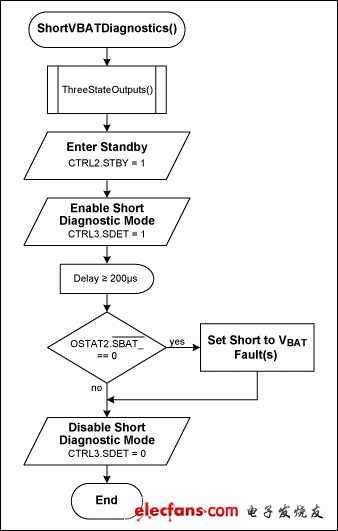Diagnosing Automotive Faults with Class D Audio Amplifiers(3)
Load Diagnostics
Short-to-Battery Diagnostic Procedure
This diagnostic detects a short to battery or ground of less than 1kΩ on any output. The diagnostic for short to battery is done in the same diagnostic mode as the short to ground, however, the device must be in standby mode to run the short-to-battery diagnostics. None of the results are latched, so the OSTAT2 register must be read while running this diagnostic to obtain a valid status.
If the load is present, a short on either of the differential outputs results in a short on the other output. Therefore, the OSTAT2 status register only indicates which channel's output is shorted and not which of its differential outputs is shorted. The I²C status register can indicate, for example, that output 1 is shorted to battery; it cannot differentiate between an OUT1+ and OUT1- short to battery.
To determine if a short to ground or battery exists on any of the outputs, three-state all outputs through I²C and enter standby (CTRL2.STBY = 1). Run the short-to-ground/battery diagnostic by setting the CTRL3.SDET (short-to-ground/battery diagnostic enable) bit to 1. The results of the diagnostic are reported in the OSTAT2.SBAT[3:0] (short-to-battery indicator) bits. Ignore all other fault indications as they are not valid.
Because no latch is set, a short to ground or battery does not prevent the device from powering up. Therefore, the microcontroller can enable the device into a short, although this configuration is discouraged. Should the device be enabled into a short, the real-time overcurrent will latch the shorted channel off. The MAX13300/MAX13301 offer real-time protection for short to battery, short to ground, and shorted load to prevent damage to the device.
Step-by-Step Procedure (Figure 4)
- The device must be in standby mode to complete this diagnostic. If starting from MUTE or PLAY mode, follow the normal shutdown procedure to prevent click-and-pop.
- Enable the short-to-battery diagnostic by setting CTRL3.SDET = 1.
- Wait a minimum of 200µs.
- Read the OSTAT2.SBAT[3:0] bits for results.
- Disable the short-to-battery diagnostic by setting CTRL3.SDET = 0.

Figure 4. Short-to-VBAT diagnostic procedure.
- 第 1 页:Diagnosing Automotive Faults with Class D Audio Amplifiers(1)
- 第 2 页:Three-State Procedure#
- 第 3 页:Load Diagnostics#
- 第 4 页:Short-to-Ground Diagnostic Procedure#
- 第 5 页:Open Load Detection#
- 第 6 页:Shorted Load/Resistance Measurement Detection#
- 第 7 页:Tweeter Detection#
- 第 8 页:Continuous Diagnostics#
本文导航
非常好我支持^.^
(0) 0%
不好我反对
(0) 0%
相关阅读:
- [新品快讯] 新唐科技推出emPowerAudio系列ISD810X音频功放 2011-03-22
- [电子动态] Wolfson推出高传真音讯(HD Audio)新产品线 为PC和NB掀 2011-01-27
- [厂商新闻] 欧胜面向电脑和笔记本电脑推出高清晰度音频( 2011-01-09
- [新品快讯] 欧胜微电子推出WM8958音频中心(Audio Hub)解决 2010-11-08
- [模拟威廉希尔官方网站 ] High-efficiency Class D audio 2010-09-22
- [LED电路] 9个LED组成的音频电平表电路, Audio VU mete 2010-03-28
- [模拟威廉希尔官方网站 ] TV audio amplifiers—thermal te 2010-03-03
- [新品快讯] ADI推出Audio Processor全系列提供多组的DA 2010-01-25
( 发表人:爱电路 )
